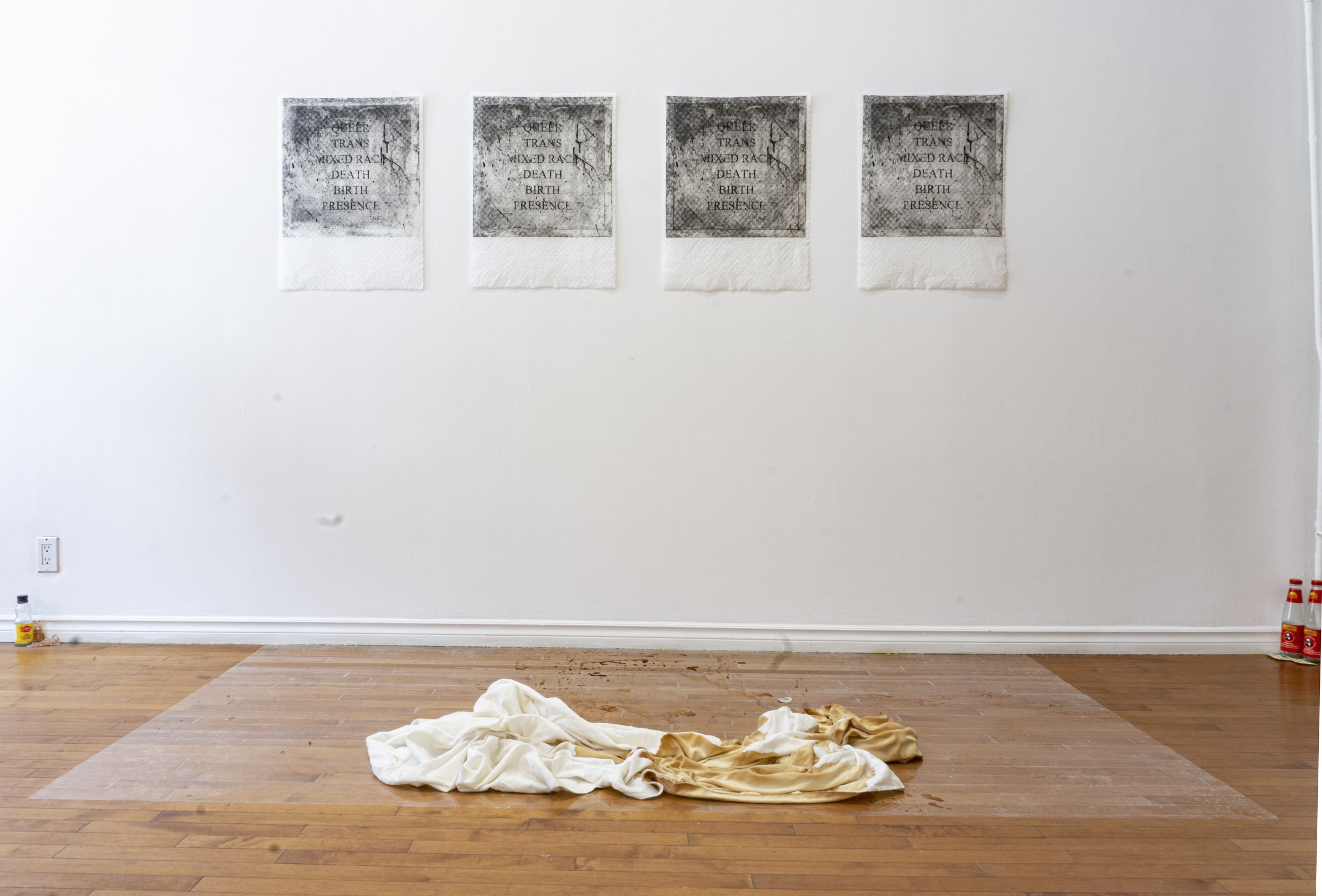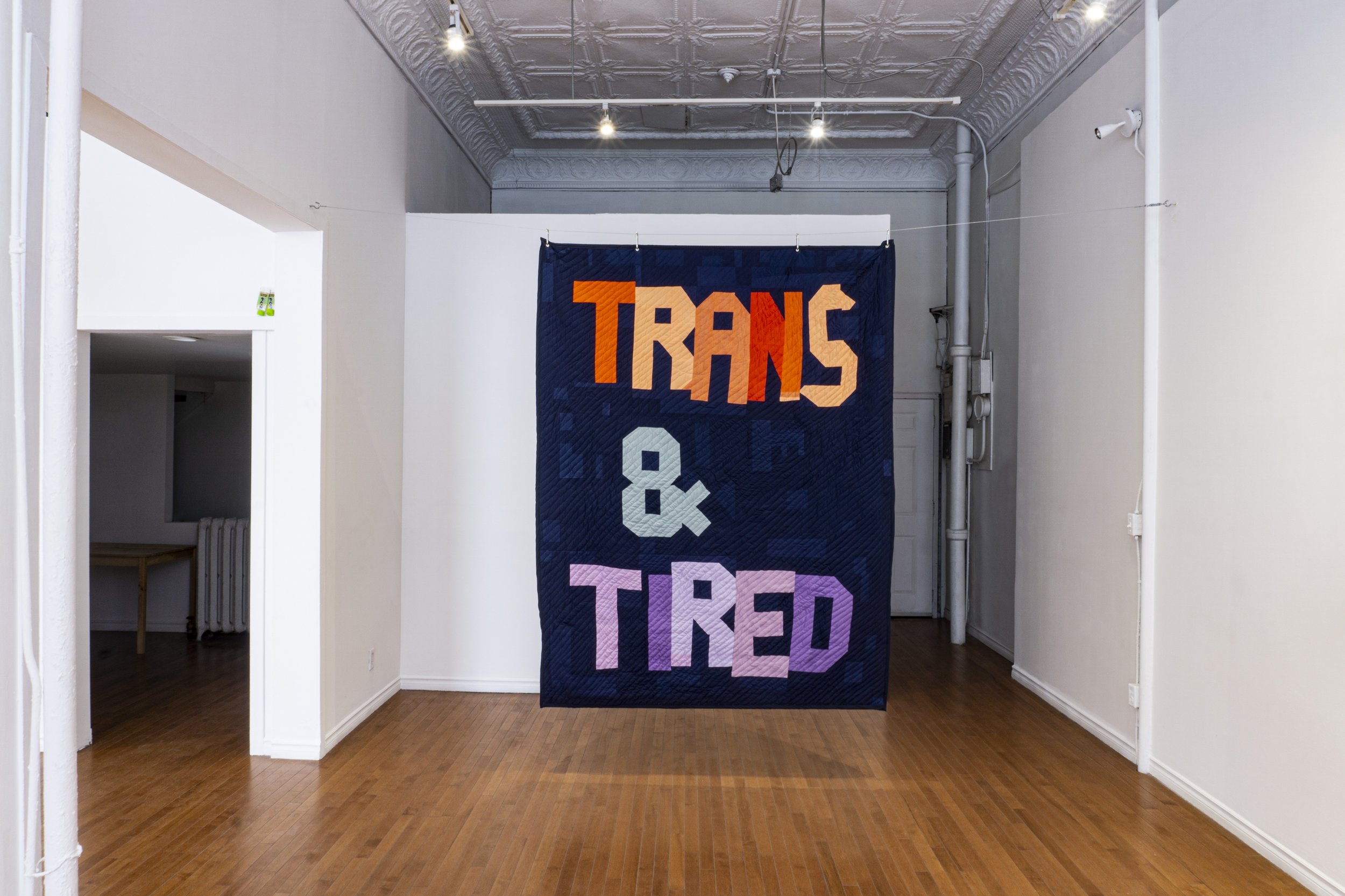
PROCESS:
PRESENCE & RESURGENCE
Andy Rubio,“The scent of my cleansing prepares my own conclusion.” Copperplate for intaglio, 2024. Photo Credit: Stride Gallery
The following curatorial essay was first published by Stride Gallery.
Process: Presence and Resurgence is a call to action for robust, unwavering support for trans artists within our local community and on a broader scale within the contemporary (so-called) Canadian art scene. This exhibition delves into the theme of rigorous, process-based art as a metaphor for the liminality of trans experiences. Artists Solana Ayida Morante, Andy Rubio, Morgan Possberg, and Levin Ifko transformed the gallery space with their unique mediums, from durational performance to painting, quilting, taxidermy, and installation.
As a curator, assembling this exhibition has been a deeply personal endeavour. Growing up in a small oil industry municipality of Fort McMurray, personal safety as a Two-Spirit trans person was (and still is) at the forefront of my mind upon entering art and non-art spaces. Tactile processes of artmaking were a coping mechanism for me, in part to combat the isolation of living in a cis-het, colonial society, but also a way I could connect with other artists.
With the backdrop of increasing transphobia, specifically in so-called Calgary, I felt it was essential to localize trans stories back to artists who call this city their home. All four exhibiting artist's practices were known to me before the beginning of the curatorial process, as I find social and artistic spheres often collide within trans circles. The process of visiting with each artist is an integral component to the exhibition’s framework. From home studio visits, phone call chats, text exchanges, and drop by’s at Stride, Process: Presence and Resurgence offers insight into what trans solidarity can be.
Andy Rubio's intaglio copper plate is the genesis point of their two editions The scent of my cleansing prepares my own conclusion (2024) on checkered rice paper. The first edition is in regular intaglio ink, and the second is in faint green wasabi paste. Both editions contain four prints, each symbolizing a different season within nature’s and the body’s life cycles. The weighty copperplate resembles a gravestone in appearance and size, resting on the floor, leaning against the white gallery wall. Andy engraves deeply into the metal's shiny surface in the familiar serif face of Times New Roman:
QUEER
TRANS
MIXED RACE
DEATH
BIRTH
PRESENCE
Above the copperplate hang the wasabi prints that Andy has delicately stitched together using white thread in the style of a celebration banner. Andy boldly reclaims their earthly, lived narrative through the rich depth of the intaglio ink text, nailing each print directly in a cemetery-like row across the wall. Both print editions remind me of Sara Ahmed's writing in Queer Feelings, in which the author writes, “Simply put, queer lives have to be recognized as lives in order to be grieved.”
Morgan Possberg, “Where we come from,” Birchwood, Silk noils, 2023.
“Simply put, queer lives have to be recognized as lives in order to be grieved.”
During our studio visits, Andy carefully outlined the laborious and time-consuming process of caring for the copperplate before and after printing. Upon witnessing Andy's prints and copperplate, I am viscerally reminded of the emotional havoc that deadnaming, misgendering, and transphobic language can wreak on (the) body, mind, and spirit. Andy playfully places soy sauce packets, wasabi paste, and a takeout food receipt around the gallery space, exhibiting small fragments of their printing process. Andy will be performing Bath Time! Go get your brother & sister~! in front of their intaglio ink prints at the halfway point of the exhibition runtime, in which they will be cleansing their nude body alongside the copperplate with jugs of soy sauce. The act of washing resembles moments from childhood, and the food materials of wasabi, soy sauce, and rice checkered paper is a gentle gesture towards their maternal heritage.
Similarly, Solana Ayida Morante's large-scale acrylic painting Decomposition (2024), alludes to the transitional state of the physical body returning to the earth. Reaching toward the tall ceiling, Solana's painting appears as a portal. It reads like a scroll on display, with the bottom yards of the rolled canvas intentionally unavailable for the viewer's consumption. The woman in Decomposition is held in a pool of deep blue hair, creating a protective chrysalis of entangled flora and fauna, warmed by a burst of yellow.
Solana breathes life into the figure's face with a slight head tilt, her features outlined in the same spectacular hue of blue. The relaxed posture of the woman within her painting signals Solana's intentional representation of the figure's internal contentment in her return to natural circadian rhythms and life cycles. The hairy leg of an insect juts out from the woman’s cocoon, with the insect’s pinchers readily available perhaps as a defense mechanism to protect the woman from prospective, unseen danger. While visiting Solana's home studio, she reminds me that the creative painting process may far outweigh the finished result. Deeply concerning herself with colour theory, composition, and different technical aspects, she commits daily to the habitual act of painting. Through gestural mark-making, Solana offers deliberate glimpses into trans euphoria during sex in two smaller-scale acrylic paintings on wood panels. Her paintings remind me of the author Kate Bornstein, who, like Solana, also reclaims her erotic, lived experience through playful storytelling in her biography A Queer and Pleasant Danger. Hands and limbs yearnfully reach out across the circular compositions, entangled together in joyful moments of connection.
Solana Ayida Morante, “Decomposition,”Acrylic on canvas, 2024. Photo Credit:Stride Gallery
When we delve into the natural life cycles within transness, it becomes crucial to acknowledge the presence of Two-Spirit within Indigenous nations across Turtle Island. Queerness was and is still sacred, with Two-Spirit people existing since time immemorial. For Morgan Possberg, sourcing and gathering natural materials is a profound way of reconnecting to family, culture, and land. During our studio visits, I was delighted to be surrounded by their traditional materials, ranging from animal bones, hides, and furs to various dried plant medicines.
Morgan's involvement in Process: Presence and Resurgence begins with their taxidermy-like Buffalo Tail I and I (2023), whimsically protruding from the gallery walls like two buffalos standing at attention. Scraggly yet strong, the tails stretch like yearning hands, reminding me of Solana's Decomposition with the human and hairy insect limbs. Their installation refocuses my own Indigenous grief on the endless slaughtering of buffalo across so-called Canada as a direct action of colonization. Morgan's work reminds me of NDN Coping Mechanisms by poet Billy-Ray Belcourt, who details humour as powerful medicine to soothe the wounds of colonial trauma.
Morgan playfully assembles new stories within the twinning cut-outs resembling buffalo hides, with Where We Come From on handmade paper and Hair Blood Guts (2023) on painted canvas. As an interactive installation, Where We Come From utilizes wood magnets with multiple symbols, ranging from animals to buildings and transportation. Across the liminal space of the handmade paper, Morgan invites the viewer to reassemble the magnets at their leisure, similarly to fridge magnets used to learn and spell out the alphabet. Morgan reinstates the importance of the buffalo as a cultural life source alongside being a spiritually magnetic, irreverent being deserving of respect. In Hair Blood Guts, the blunt, straightforward text in sphagnum moss reminds me of Andy's wasabi and intaglio ink prints, directly referring to embodied processes surrounding death. Morgan highlights the importance of sphagnum moss, harvested across Indigenous cultures for menstrual cycles, baby diapers, and cradleboards.
Morgan Possberg, “Hair blood guts,” Canvas, acrylic,reindeer moss, 2023.
Levin Ifko playfully invites viewers to an endless game of tic-tac-toe within his Ultimatum, Baby! (2022), an interactive sculpture. Levin transforms each binary x and o spinnable piece into a snapshot into their lived experience, with each side of the spinnable cubes featuring prints of the artist's face, hands, drawings, and glimpses of flowers. Each cube representing an x or an o spans from early childhood to the present. Like Solana, Levin blends figures and landscapes, showcasing multiple iterations within the seasons of their life. Through Ultimatum, Baby! Levin encourages viewers to spin their new personal narratives outside the rigidity of the gender binary through a tactile, fun experience.
In studio visits with Levin, I am in awe of their upbeat, steady approach to exploring new material processes, such as embarking on the quilt installation Trans & Tired (2024). Levin stitches the work's title in large block letters as a blazing emblem in yellow, orange, and lilac across the body quilt. It hangs across the gallery space like a blanket drying in the sun. Like Andy and Morgan's direct text, Levin's Trans & Tired lettering is also straight to the point. Their work reminds me of Hannah Gadbsy's intentionally fragmented comedy special Nanette, as Levin, like the comedian, also reminds cis audiences that behind playful storytelling bears the weight of trauma stemming from transphobia.
“Often, quilts are passed down as family heirlooms, and I envision Levin stitching together a labour of love for the collective future of trans people in generations to come”
In Trans & Tired, symbols emerge on the backside of the quilt-cigarettes, hands reaching and grasping in expression similar to Solana and Morgan's pieces, small fires, and more, combining materials such as chains, glittery materials, and clothing. The underbelly of the quilt, visible in the round, offers a tender insight into what would touch the body if you were to climb into bed. Here, small text moments refer to t4t love, connection, and joy, tagged onto street signs. Levin's quilt reads as a statement about the need for trans safety and sites of comfort and rest. Often, quilts are passed down as family heirlooms, and I envision Levin stitching together a labour of love for the collective future of trans people in generations to come within so-called Calgary, Alberta.
Taking place during the springtime season, Process: Presence and Resurgence also explores the fluidity of time, rituals, and life cycles inherent to trans futures. Similarly to Levin’s quilt, I offer Process: Presence and Resurgence as a time capsule for future generations of Two-Spirit, trans, non-binary artists in so-called Calgary. I hope they receive this exhibition and each of the incredible artists’ artwork, conversations, and presence as encouragement to persevere.

Levin Ifko, “Trans & Tired,” Hand and machine-sewn quilt with mixed cotton, fibres, 2024.





